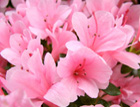Christmas Azaleas and Topiary
Roddy Llewellyn advises how to make the azaleas last longer than a matter of weeks, and suggests how to get started for those who would dabble in topiary


The period after Christmas witnesses torture on a massive scale. I am thinking particularly of the so-called 'Indian' azaleas so often given as presents. Armies of them are sold, but few see it through alive to the New Year, ending up, I fear, dead and desiccated in the dustbin. They are forced to sit in pride of place in the centrally heated sitting room in a smart cachepot where no one remembers to water them. It is a far cry from the sort of conditions the parents of these hybrids enjoy in their damp woodland habitats in the Far East.
I keep mine going for years, and they grow larger and larger, becoming magnificent and graceful plants with flowers that last for about two months. The art is to store them in the cool as much as possible, with the compost kept damp at all times. I always take mine out of hot rooms after entertaining, and put them in a frost-free shed or outside if the weather proves mild. After flowering, they are happy sitting in an unheated glasshouse or shed (by the window) until the last frost is over and then placed outside in the shade, having been repotted with ericaceous compost. Indian azaleas are acid-soil lovers and resent tap water as it usually errs on the side of alkaline: sweet or rain water is what they crave. In late summer, a liquid feed with a potash-rich product such as Tomorite will encourage a fresh show of flowers.
As I whizz about the country in my motor (I've always been partial to a good whizz), I am constantly on the lookout for imaginative ideas employing evergreens. After all, it is they that save the garden from being reduced to a mere mass of bare twigs in the depths of winter. I am not thinking about evergreen trees per se, but rather living sculpture as in topiary
Topiary derives from the Latin topiarius, mentioned by Cicero as a higher class of slave, a gardener whose job it was to shape plants. The Romans?the first recorded people to have had containerised plants on their roofs and outside the windows belonging to their apartment blocks?used to tie, twist and cut various trees and shrubs into different shapes. Today, the art of topiary mainly involves the cutting of (mostly evergreen) plants with shears.
So why hasn't everyone got a shaped evergreen in their garden to add winter cheer? Perhaps it is because most people do not feel sufficiently confident to be able to succeed with topiary, but you do see the occasional huge teddy bear or battleship clipped into the hedge of a cottage garden, and what a joy they are to behold. There isn't nearly enough of it about.
All you need to do as a beginner is to choose the right spot in the garden?oh, and it does help to decide on the eventual shape you are aiming for. If you're cramped for space, go for an upright shape, perhaps a cone, or a tiered-cone, essentially a wedding cake. 'Lollipops' are always rather irresistible, too, but if you have more space, be brave and venture forth into the world of bare-breasted ladies, peacocks, pigs, horses, hares or even crocodiles.
For larger shapes, yew Taxus baccata, is an excellent plant, although its Achilles heel is its inability to cope with poorly draining ground. Having planted a small yew from a two-litre pot, you then need do absolutely nothing for three years, except for keeping its base clear of weeds and watering it in dry weather, after which time it resembles a louche youth with tousled hair. Small-scale shaping can start in its fourth season and by that time you will have decided, with any luck, on your preferred shape.
Exquisite houses, the beauty of Nature, and how to get the most from your life, straight to your inbox.
Common box or Buxus sempervirens, Portugal laurel or Prunus lusitanica, Holm oak or Quercus ilex, holly, bay tree and Phillyrea angustifolia (making a comeback after its zenith of popularity in the 17th century) are other evergreen plants to consider once you have become sufficiently confident to branch out, if you will forgive the pun.
I once went to a famous topiary garden and on the way out my companion said to me: 'I don't like yew', which, for a second or two, I took rather personally, until I realised they were actually referring to the plant.
Country Life is unlike any other magazine: the only glossy weekly on the newsstand and the only magazine that has been guest-edited by His Majesty The King not once, but twice. It is a celebration of modern rural life and all its diverse joys and pleasures — that was first published in Queen Victoria's Diamond Jubilee year. Our eclectic mixture of witty and informative content — from the most up-to-date property news and commentary and a coveted glimpse inside some of the UK's best houses and gardens, to gardening, the arts and interior design, written by experts in their field — still cannot be found in print or online, anywhere else.
